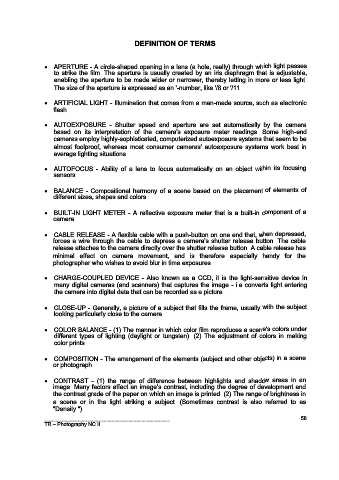Page 514 - aREA ix eXHIBITS
P. 514
DEFINITION OF TERMS
APERTURE - A circle-shaped opening in a lens (a hole, really) through which light passes
to strike the film. The aperture is usually created by an iris diaphragm that is adjustable,
enabling the aperture to be made wider or narrower, thereby letting in more or less light.
The size of the aperture is expressed as an '-number, like '/8 or '/11.
ARTIFICIAL LIGHT - Illumination that comes from a man-made source, such as electronic
flash.
AUTOEXPOSURE - Shutter speed and aperture are set automatically by the camera
based on its interpretation of the camera's exposure meter readings. Some high-end
cameras employ highly-sophisticated, computerized autoexposure systems that seem to be
almost foolproof, whereas most consumer cameras' autoexposure systems work best in
average lighting situations.
AUTOFOCUS - Ability of a lens to focus automatically on an object within its focusing
sensors.
BALANCE - Compositional harmony of a scene based on the placement of elements of
different sizes, shapes and colors.
BUILT-IN LIGHT METER - A reflective exposure meter that is a built-in component of a
camera.
CABLE RELEASE - A flexible cable with a push-button on one end that, when depressed,
forces a wire through the cable to depress a camera’s shutter release button. The cable
release attaches to the camera directly over the shutter release button. A cable release has
minimal effect on camera movement, and is therefore especially handy for the
photographer who wishes to avoid blur in time exposures.
CHARGE-COUPLED DEVICE - Also known as a CCD, it is the light-sensitive device in
many digital cameras (and scanners) that captures the image - i.e converts light entering
the camera into digital data that can be recorded as a picture.
CLOSE-UP - Generally, a picture of a subject that fills the frame, usually with the subject
looking particularly close to the camera.
COLOR BALANCE - (1) The manner in which color film reproduces a scene's colors under
different types of lighting (daylight or tungsten). (2) The adjustment of colors in making
color prints.
COMPOSITION - The arrangement of the elements (subject and other objects) in a scene
or photograph.
CONTRAST - (1) the range of difference between highlights and shadow areas in an
image. Many factors affect an image’s contrast, including the degree of development and
the contrast grade of the paper on which an image is printed. (2) The range of brightness in
a scene or in the light striking a subject. (Sometimes contrast is also referred to as
"Density.")
________________________________________________ 58
TR – Photography NC II

